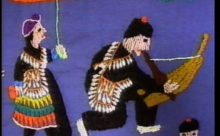Rhode Island School of Design website Article titled "The Art of Hmong Textiles/ Hmong Textile Collection risdmuseum.org
The Hmong are a distinct ethnic group who for thousands of years lived as one of a number of minority peoples in China, where they are known as the Miao or Meo. Although more than 5,000,000 Hmong still live in several southwestern provinces of China, over the centuries many have migrated to the mountains of Laos, Thailand, Burma, and Vietnam where they established farming villages in the highlands.
In the 1960s and 1970s, Hmong tribesmen living in the hills of Laos helped American military efforts to stop the communist take-over of that country, and gave aid to downed fliers from the war in neighboring Vietnam. In 1975 when the war was lost and the Americans withdrew, the Hmong were sought out and massacred by the ruling Pathet Lao. With great hardship and loss of life, thousands of Hmong went into hiding and searched for the border. Those who successfully crossed over the Mekong River into Thailand faced more hardships in the refugee camps, where many still live, while waiting to resettle in the United States and other countries.
In mid-1988 about 118,000 Hmong lived in 71 communities in thirty states in this country, most in California and Minnesota. In Rhode Island there were 2178 Hmong,
forming 311 families. Each year between 150 to 200 Hmong come to Rhode Island from the camps, but at the same time, established Hmong move in or out of state in order to resettle with members of their own clan and to seek better opportunities.
This pattern of movement is not new. In Laos, extended families would move to a new area after the soil in their village was exhausted through the "slash and burn" agriculture that was the foundation of their economy. Families also kept pigs and cattle. Against the difficulties of living in a harsh climate and being forced to move often, the Hmong have tightly knit extended families and great loyalties to their patrilineal clans, of which there are at least twenty. In the United States it is not unusual when relatives have been resettled at great distances for whole families to move to join their clans.
The Hmong divide themselves into a number of sub-groups whose names reflect the color of their traditional clothing and whose dialects and customs differ. Most Laotian Americans, including those in Rhode Island, are either White Hmong or Blue (sometimes called Green) Hmong. In this exhibition, these divisions are reflected in the traditional costumes on display. Made by women for their families, they are decorated with painstaking embroidery and reverse applique. The patches used to decorate costume in Laos were the forerunners of the textiles the Hmong make in the camps and in this country for sale to Westerners. Both types are shown here.
Although there was no written language until the 1950s, stories told and retold by elders of each group served to explain Hmong history, recount tribal customs, and transmit cultural values. The storytelling skills of men and the embroidery skills of women have been combined in the "story cloths" made in the refugee camps and less and less in this country, where most Hmong must work outside the home.
All of the textiles and costume in this exhibition were produced by Hmong refugees from Laos, in Laos, Thailand, or the United States, and show the effects of the difficult transition this courageous people have been making in the last twenty years of upheaval and resettlement in a new and vastly different country.
